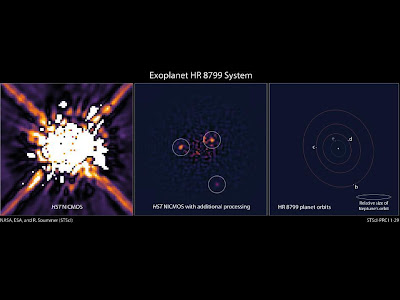In a careful analysis of the Hubble Space Telescope images in 1998, astronomers have found visual evidence of the two exoplanets, have gone unnoticed at the time.
Finding these hidden gems Hubble archive to provide astronomers with a valuable comparison of the time machine, much earlier than the planet's orbital motion data to new discoveries. It also demonstrates a new approach to the hunting world for the storage of the Hubble data.
Four giant planets known to orbit the massive young star HR 8799, which is130 light years. In 2007 and 2008 the first three planets have been discovered in infrared images taken near the ground with the WM Keck Observatory and the Gemini North telescope by Christian Marois, the National Research Council of Canada and his team. Marois and his colleagues found nearby planet fourth in 2010. It is the only system that astronomers have obtained exoplanetary multiple images directly.
In 2009, David Lafrenière, University of Montreal, exoplanet data retrieved hidden in the Hubble images taken in 8799 of HR 1998 with the Near Infrared Camera and Multi-Object Spectrometer (NICMOS). He identified the position of the outermost known planet of the star's orbit. That first demonstrated the power of a data processing technique for the recovery of new minor planets buried in the brightness of the star.
A reanalysis of the same data archival NICMOS by Remi Soumen the Space Telescope Science Institute in Baltimore has recovered all three outer planets. The fourth closest planet is 1.5 billion miles from the star and is not visible because it is on the edge of the NICMOS corona graphic spot that blocks light from the central star.
Finding planets in multiple images, spread over the years, the orbits plotted. Knowledge of the pathways are crucial for understanding the behavior of multi-planet, because massive planets can affect each other orbits. "From the Hubble images, we can determine the shape of their orbits that provide an overview of the stability of the planet masses and eccentricities, and also the inclination of the system," says Soumen.
These results are published in the Astrophysical Journal.
The three gas giant outer planets is about 100 -, 200 - and 400-year orbit. This means that astronomers have to wait long to see how the planets move along their path. The added time to the Hubble data will help greatly. "The file has been 10 years of science right now," he said. "Without these data, we would have to wait another decade. It's 10 years of science for free."
However, the slower the movement, the outer planet, has just become the station for 10 years. "But if we go to the next inner planet, rarely seen in orbit, and the third inner planet, we will actually see a lot of movement," says Soummer.
The planets were observed in 1998, when Hubble's observations were the first taken since the method used to detect them is not available at this time. When astronomers reduce the light from the star center to search for the afterglow of the planets, the scattering of light was even more planets remaining weak.
Lafrenière developed a way to improve this type of analysis using a library of reference stars more precisely to eliminate the "fingerprint" of the central star light. The team took Soumm Lafrenière method one step further and use 466 images of the stars of a reference library with more than 10 years of NICMOS observations assembled by Glenn Schneider of the University of Arizona.
Soummer team increased the contrast and minimize the rest of the Starlight. They completely removed from the diffraction peaks, which are the objects common to the imaging systems of the telescope. This allowed them to see two poor inner planets, the Hubble data. Planets recovered from NICMOS data are about 1 / 100, 000 brightness of the parent star, when viewed in the near infrared.
Soumen next plans to analyze about 400 other stars in the NICMOS archive with the same technique that improves image quality by a factor of 10 of the imaging methods used where data were collected.
Soummer work shows the power Hubble Space Telescope data archive, which houses the images and spectra of more than twenty years, the Hubble observations. Astronomers use this library to integrate the new discoveries with a lot of valuable information already collected, resulting in a lot of opportunities for the discovery of new experience.
NICMOS data team will meet Soumm file a list of candidates worldwide to be confirmed by ground-based telescopes. If the planets are discovered, they will have several years to measure the orbital motion.
Hubble Space Telescope is a project of international cooperation between NASA and the European Space Agency. NASA Goddard Space Flight Center manages the telescope. The Space Telescope Science Institute (STScI) is implementing the Hubble science operations. STScI is operated for NASA by the Association of Universities for Research in Astronomy, Inc., Washington, DC

Tidak ada komentar:
Posting Komentar